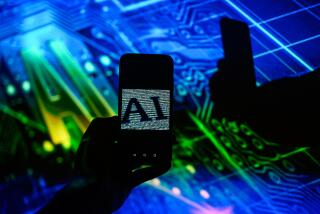The Computer of the Near Future Will Feel Your Pain and Respond
- Share via
CAMBRIDGE, Mass. — Take a deep breath and repeat after me: It’s only a machine . . . it’s only a machine . . . it’s only a machine.
There’s no question we have strong feelings about the computers in our lives. In a British study, three-quarters of PC users acknowledged they cuss at their computers now and again. One-quarter confessed to kicking their machines. Sound familiar?
*
People tend to treat their computers as though they were human, “even if you are a computer science student and know it’s a machine,” says Rosalind Picard, an associate professor at the Massachusetts Institute of Technology Media Lab, who studies the complex emotional ties between people and their PCs.
But the relationship is decidedly one-sided. While computer scientists have bestowed computers with considerable logic, the machines have long lacked heart.
Researchers are trying to change that. Recently, computer scientists gathered at MIT to discuss their latest efforts to teach machines how to become more touchy-feely, a relatively new niche in computer science known as “affective computing.”
The advantage: A computer that responds to emotion could be easier to use. “I think what we need to do is make the computer human literate,” Walter Mossberg, technology columnist of the Wall Street Journal, told the crowd of researchers and computer industry executives.
It’s not that researchers haven’t tried before. In the 1960s, programmers created a computer psychologist called “Eliza” designed to banter with users who typed in questions. But Eliza’s responses, determined by primitive, pattern-matching techniques, often came out of left field.
*
In 1995, Microsoft unveiled “Bob,” an avuncular “intelligent agent” designed to make inexperienced computer owners feel more at ease. But Bob was a boob--and Microsoft soon dumped him (although he reappeared in simpler form as the animated assistants in Microsoft Office). “It was ahead of its time,” Microsoft Chairman Bill Gates said last month in a television interview with the BBC.
Still, Gates and others are convinced that it’s only a matter of time before your computer gets a personality (or at least a good imitation of one). One hurdle, researchers say, is teaching computers to read the subtle biological clues that betray our feelings.
To that end, the MIT Media Lab is experimenting with a “squeezable” computer mouse with built-in pressure sensors that can pick up on tension. “Just about once a week, I get so angry I want to throw my computer out of the window,” said Carson Reynolds, an MIT graduate student working on the device.
How would the squeezable mouse help? Reynolds demonstrated using a modified version of Microsoft Office 2000. He attempted to type a letter to a “Mr. Abotu,” a surname that the software’s automatic spell checker repeatedly changed to “Mr. About.”
When the computer sensed that Reynolds was starting to boil, the animated Office paper clip popped up: “It seems as if you’re frustrated,” it said. “Should I turn off AutoCorrect?”
*
Another emotion detector under development at MIT is the “galvactivator,” a glove that measures the subtle electric current that our skin produces when we get emotional.
The glove contains a jack designed to pass data to a computer and a tiny red light-emitting diode. The more excited the wearer becomes, the brighter the bulb glows. “Personally, mine tends to glow a lot when I think about chocolate,” confesses Jocelyn Scheirer, the Media Lab grad student who helped design it.
By plugging the galvactivator into a modified version of the popular computer shoot-’em-up “Quake,” MIT students can watch as their virtual alter egos spring backward in response to their shock at what’s happening on screen.
MIT has more wearable sensors in the works: earrings that can read rising blood pressure, eyeglasses that detect a furrowed brow, and hats with a camera in the brim to scan facial expressions.
But detecting the biological tell-tale signs of human emotions is half the battle. Computers must learn how to interpret these signals and respond appropriately--skills that most humans find difficult to develop.
*
Jack Breese and his colleagues at Microsoft Research are working on intelligent agents that can speak to the user in tones ranging from brusque (“Excuse me! You need help!) to obsequious (“I’m sorry to bother you, but may I help?”). The theory is that different human personality types may work better with different computer-based agents.
Using body cues, MIT’s Picard has been able to teach computers how to recognize basic human emotions, such as anger or joy, 81% of the time. Picard compares the state of today’s emotion-recognition technology to the crude speech recognition of the 1950s--it’s possible only in a strictly controlled environment.
“We still have a ways to go,” she said. But she and colleagues are optimistic that it won’t take long to make up the ground. “We ought to be able to cut 50 years down to five or 10 years,” she declared.






